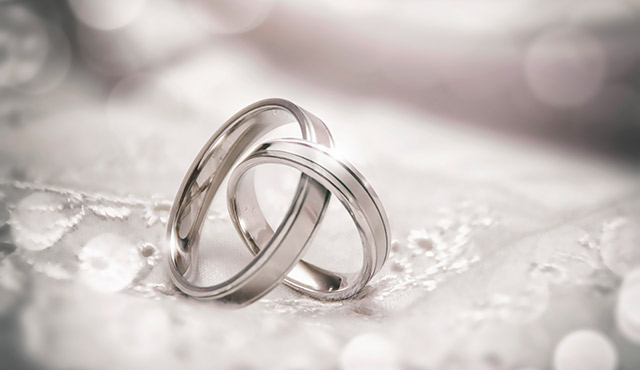Historically, the shape of a ring has always been a symbol of eternity. However, the customs of the wedding ring evolved significantly over time.
The origin of the wedding ring dates back thousands of years ago in ancient Egypt, where evidence was found on relics that showed braided rings of hemp being used as bonds between married couples. The practice later spread to Europe where the ring was typically made of iron and only worn by the bride, symbolizing that she was now the groom’s possession. Eventually, silver and gold replaced iron because of how it easily rusted. By the 16th century, gimmel or gimmal rings became popular in Europe as betrothal rings. When couples became engaged, each person would wear an interlocking gimmel band. On their wedding day, the rings were joined as one band and would be worn by the bride.
Although women wearing the wedding band can be traced back several centuries, the practice of men wearing a wedding ring is somewhat recent. It wasn’t until World War II that married soldiers who were away from their wives for long periods of time, began wearing wedding rings as reminders of the love waiting for them at home and as a symbol of hope during a dark period.
In the Catholic Church, the wedding ring is one of the blessed symbols in the celebration of the sacrament of matrimony.
“In a lot of traditions, the rings were a very big symbol because they wanted to show a material manifestation of that bond,” says Father Troy Schneider, parochial vicar of Holy Family Cathedral in Orange. “With Catholics it’s always been about consent. That’s a priority. It’s when they say, ‘Yes, I want to marry you and I’m doing this freely.’ Or ‘Yes, I want to have children with you and I’m doing this freely and I will love and honor you for the rest of your life.’ Those words being spoken and lived out by the couple in the Catholic tradition surpasses the rings. The ring is a reminder to them of their consent, of their vows. So in the Catholic tradition, it’s not a sign of possessing each other. It’s about the vows that were exchanged and a reminder of those vows are the rings which manifest that.”
The ring is just one of the powerful and meaningful symbols in a wedding ceremony.
“The language of ritual and liturgy is always the language of sign and symbol,” explains Monsignor Arthur Holquin, pastor-emeritus of Mission Basilica San Juan Capistrano. “Signs and symbols play a biblically important role in helping to understand the meaning of important moments. For example, in the sacrament of baptism, there is water. In the Eucharist, bread and wine. And in the anointing of the sick, oil. The ring, which is a traditional element of the wedding ritual, is not the primary symbol of marriage. The primary symbol is the bodily presence of the husband and wife who give and receive the sacrament to each other.”
So, where does the ring fit in?
“Well as in many sacraments, these moments are enriched by the symbols that help to bring out the significance of the primary symbol and one of those secondary symbols is the ring,” explains Monsignor Holquin.
What isn’t important is the size of the stone or whether silver or gold. Rather, the vows exchanged and the commitment made with each other hold a much deeper meaning.
“I often say to a couple on the day of their marriage, that as the rings are blessed, the words of the blessing indicate the meaning. The blessing says that these rings are a sign of your love and fidelity and that people in love make signs of love and the wedding ring is a sign of your commitment,” Holquin says. “Every time you look upon that ring or others look upon it, they will know that you belong in love and fidelity to another and that it is a perpetual reminder to you of that biblical covenant and that loving bond that you have forged with one another in Christ.”
Wedding ring trends
Late 1920s: White gold made its introduction into wedding ring fashion.
1930s: Art Deco influenced rings became the trend.
1940s: Yellow and rose gold bands were commonly used.
1945: The “War Bride Ring” was the only option for soldiers to choose from during the rationing of precious metals during the war.
1950s–60s: White gold and platinum rings became popular in the postwar era.
1960s–70s: Emerald-cut, pear, marquise and heart-shaped diamonds were in trend and platinum remained popular.
1970s–80s: Fancy shaped diamonds continued to be popular and the gold setting became trendy.
1990s–2000s: A radiant cut diamond set with triangular side stones becomes fashionable.
2000s–10s: The princess cut diamond gains popularity.
2010s–present: Platinum bands with a “halo” mounting and fancy colored diamonds are the new trend.
Sources: elle.com ‘100 Years of Engagement Rings’, brit.co ‘Engagement Ring Trends Throughout the Decades’

